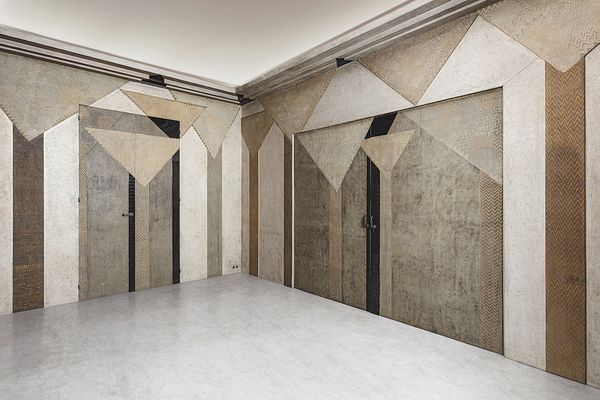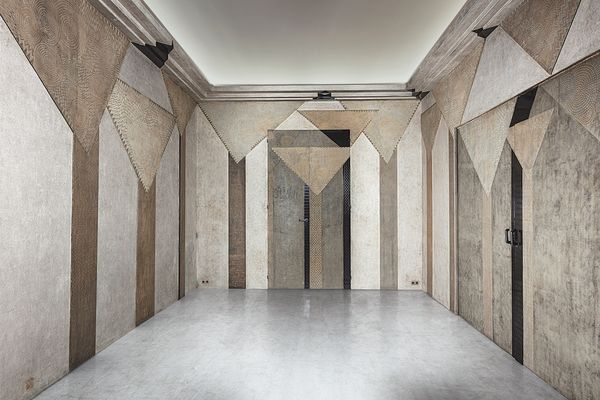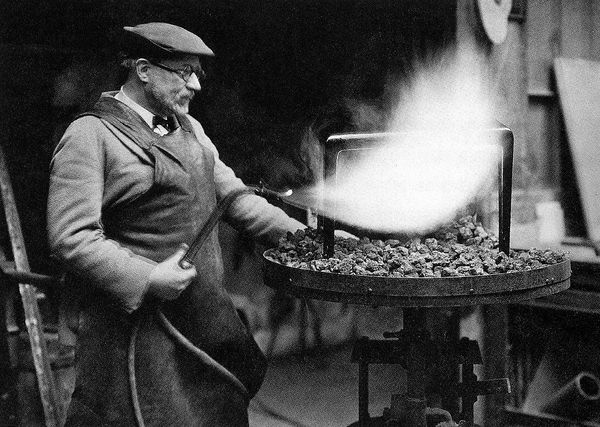Jean Dunand, Les Palmiers smoking room, from the residence of Mademoiselle Colette Aboucaya, Paris, 1930-36. Estimate £1,500,000 - 2,000,000. Design London.
Written by Alexandra Jaffré
An invitation to travel...to sail through the waves of luxury in the vessel of modernity, this is what Jean Dunand promised to Mlle Colette Aboucaya when she commissioned the decoration of the smoking room of her Parisian apartment. When she discovered the final work installed, the patron could never have imagined this unique interior would enter the pages of the history of decorative arts as an iconic expression of French luxury. An expression of savoir-vivre, an appetite for modernity, a spirit of travel, a taste for the original and luxury: these are the ingredients that define the Art Deco period and that are united in the commission realized for this Parisian patron.
The savoir-vivre of the roaring twenties elevated the privilege of time to the level of art. The lacquering and sanding process are synonymous with patience and meticulous work, which can last for many months or even years depending on the ambition of the project. Once prepared the base then requires between ten and twenty layers of lacquer that need to be dried between each step and then sanded in a suitable environment. During this period, elite collectors understood that opulent interiors required patience on their part. In this smoking room—in which time is suspended among the billows of smoke—guests could find refuge far from the trepidation of city life, in an environment conducive to intimacy.
Jean Dunand, Les Palmiers smoking room, from the residence of Mademoiselle Colette Aboucaya, Paris, 1930-36. Estimate £1,500,000 - 2,000,000. Design London.
The appetite for modernity reigns in this interior in which Dunand created a decor characterized by vigorously geometric lines. This is the spirit of Art Deco, which worships the inventions of the engineer. However, the resulting strength is tempered by the softness of the powdered pink color chosen for the furniture by the decorator Gérard Mille, which reflected the tones of the carpet by Ivan da Silva Bruhns. Dunand offered here with his masculine stylistic approach his own interpretation of the apartments of the hôtels particuliers during the reign of Louis XV, in which the ornamentation, consisting of organic curves enhanced by gold and color, expressed an ode to femininity. Dunand adhered to the prayers of his intellectual contemporaries who aspired for the decorative arts to reach the same degree of excellence achieved during the eighteenth century, so that France could shine again in Europe. As such the masculine elegance of the present interior embodies the essence of French Art Deco.
Awaiting the host and his visitors, distant islands covered with palm trees can be reached by the gondola-shaped daybed. Born from Katsu Hamanaka’s imagination, the refined lines of the daybed’s frame are covered with exotic shagreen and lacquered using the same-nuri technique, an alliance between yin and yang in the Far Eastern equilibrium. The solid and slender shape of the daybed evokes the Oceanian pirogues led by intrepid conquerors. It is difficult not to draw a parallel with the living room fully covered with lacquer panels and the pirogue designed a few years earlier by Eileen Gray for the millinery J. Suzanne Talbot. Gray and Dunand shared the same master, Seizô Sugawara, who taught them the ancestral techniques of lacquer, a closely guarded secret since immemorial times. They each transformed these techniques through the prism of modernity. Whilst Gray transferred her dreams of starlit spaces into lacquer, in the heart of Paris, Dunand transplanted an exotic cubist-inspired forest lacquered in silver, tempered with elements of gold and ochre. No figurative element disturbed the rhythm of the line and the circle, harmoniously combined by the symphony of tones. The decoration achieved a timelessness that becomes a support for an inner journey. Designed a few years after the 1925 International Exhibition, the interior’s decoration was the culmination of the smoking room Dunand had designed for the French Embassy, which had contributed to the glory of the exhibition.
View from ‘Les Palmiers’ smoking room illustrating the daybed designed by Katsu Hamanaka (lot 34). © DR.
Léon Aboucaya and his brother, the father and uncle of the patron, developed a taste for novelty and luxury having acquired the coachbuilding company of Henry Binder in 1928. Their ambition was to create the haute couture of automobiles. Executed in rare materials, each car was considered a work of art. The brothers entrusted Dunand’s workshop with the realization of lacquer imitating shagreen or covered with gold and applied on modernist motifs.
Because of the visual effect and durable qualities of the lacquer when applied to this symbol of freedom and speed, the master coachbuilders further elevated this material as an art of living. Therefore, it is not surprising to find that Mlle Colette Aboucaya shared this passion for lacquer, a noble and precious material which can be combined with gold, shagreen and mother-of-pearl. A poem for the eyes and an invitation to caress. Similarly, the wife of the coachbuilder Jean Henri-Labourdette commissioned Dunand to decorate the living room of her Paris apartment but in this case based on the exotic theme of hunting.
Jean Dunand testing the durability of the lacquer with a blowtorch, 1931. Photograph by Albin Salaün.
The modernity of the present smoking room was not conceived to please the most aristocratic members of the Parisian circles, who were conservative and cautious towards change. To mark their social standing and earn the acceptance of the upper classes, many industrialists and those who had made new fortunes preferred to build more classic collections focusing on eighteenth-century painting, furniture, and objets d’art—a conservative and safe investment, but not very ambitious. A spirit of independence and contempt for commonly followed paths was required to resist this pressure. By choosing the bet of modernity, Mlle Colette Aboucaya belonged to a lineage of women who conquered the modern city. Among them were milliners, fashion designers and collectors who loved the freedom of movement of the body and were freed from convention; women such as Suzanne Talbot, Madame Agnès and Louise Boulanger who marked their time and who we continue to speak about today.
Admiring the elegant palm trees creates a suggestive force that transports the contemporary traveller to a parenthesis of French excellence: the Art Déco period. In their sap the eternal youth of modernist poetry flows.
Alexandra Jaffré is an Art Historian and author of Seizô Sugawara, maître laqueur d’Eileen Gray.
Discover More from Design London >
Recommended Reading
Creating and Defining Space: A Pair of Vitrines Designed by Carlo Scarpa >




